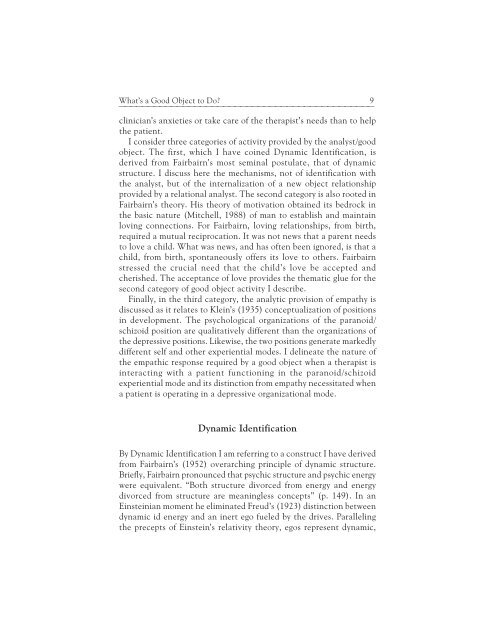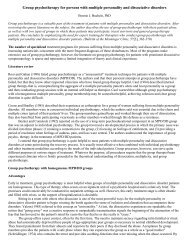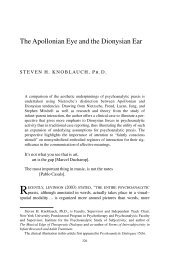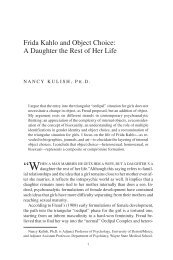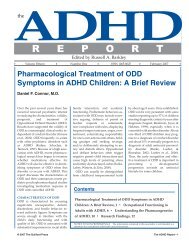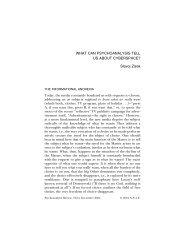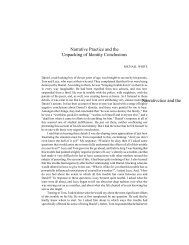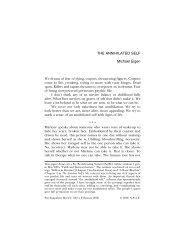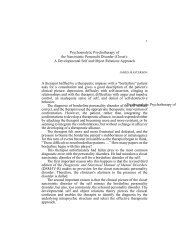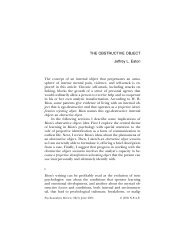What's a Good Object to Do? - PsyBC
What's a Good Object to Do? - PsyBC
What's a Good Object to Do? - PsyBC
Create successful ePaper yourself
Turn your PDF publications into a flip-book with our unique Google optimized e-Paper software.
What’s a <strong>Good</strong> <strong>Object</strong> <strong>to</strong> <strong>Do</strong> 9<br />
⎯⎯⎯⎯⎯⎯⎯⎯⎯⎯⎯⎯⎯⎯⎯⎯⎯⎯⎯⎯⎯⎯⎯⎯⎯⎯⎯⎯⎯⎯⎯⎯⎯⎯⎯⎯⎯⎯⎯⎯⎯⎯⎯⎯<br />
clinician’s anxieties or take care of the therapist’s needs than <strong>to</strong> help<br />
the patient.<br />
I consider three categories of activity provided by the analyst/good<br />
object. The first, which I have coined Dynamic Identification, is<br />
derived from Fairbairn’s most seminal postulate, that of dynamic<br />
structure. I discuss here the mechanisms, not of identification with<br />
the analyst, but of the internalization of a new object relationship<br />
provided by a relational analyst. The second category is also rooted in<br />
Fairbairn’s theory. His theory of motivation obtained its bedrock in<br />
the basic nature (Mitchell, 1988) of man <strong>to</strong> establish and maintain<br />
loving connections. For Fairbairn, loving relationships, from birth,<br />
required a mutual reciprocation. It was not news that a parent needs<br />
<strong>to</strong> love a child. What was news, and has often been ignored, is that a<br />
child, from birth, spontaneously offers its love <strong>to</strong> others. Fairbairn<br />
stressed the crucial need that the child’s love be accepted and<br />
cherished. The acceptance of love provides the thematic glue for the<br />
second category of good object activity I describe.<br />
Finally, in the third category, the analytic provision of empathy is<br />
discussed as it relates <strong>to</strong> Klein’s (1935) conceptualization of positions<br />
in development. The psychological organizations of the paranoid/<br />
schizoid position are qualitatively different than the organizations of<br />
the depressive positions. Likewise, the two positions generate markedly<br />
different self and other experiential modes. I delineate the nature of<br />
the empathic response required by a good object when a therapist is<br />
interacting with a patient functioning in the paranoid/schizoid<br />
experiential mode and its distinction from empathy necessitated when<br />
a patient is operating in a depressive organizational mode.<br />
Dynamic Identification<br />
By Dynamic Identification I am referring <strong>to</strong> a construct I have derived<br />
from Fairbairn’s (1952) overarching principle of dynamic structure.<br />
Briefly, Fairbairn pronounced that psychic structure and psychic energy<br />
were equivalent. “Both structure divorced from energy and energy<br />
divorced from structure are meaningless concepts” (p. 149). In an<br />
Einsteinian moment he eliminated Freud’s (1923) distinction between<br />
dynamic id energy and an inert ego fueled by the drives. Paralleling<br />
the precepts of Einstein’s relativity theory, egos represent dynamic,


